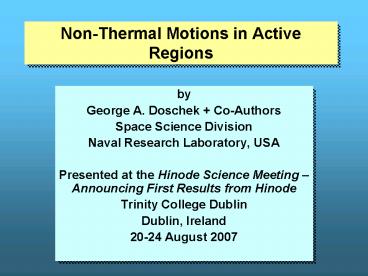NonThermal Motions in Active Regions - PowerPoint PPT Presentation
1 / 16
Title:
NonThermal Motions in Active Regions
Description:
Presented at the Hinode Science Meeting Announcing First Results ... S082-B slit spectrograph. on the Apollo Telescope. Mount, Skylab manned. space station ... – PowerPoint PPT presentation
Number of Views:16
Avg rating:3.0/5.0
Title: NonThermal Motions in Active Regions
1
Non-Thermal Motions in Active Regions
- by
- George A. Doschek Co-Authors
- Space Science Division
- Naval Research Laboratory, USA
- Presented at the Hinode Science Meeting
Announcing First Results from Hinode - Trinity College Dublin
- Dublin, Ireland
- 20-24 August 2007
2
Co-Authors See ApJL, accepted for publication
- J. T. Mariska, H. P. Warren, C. M. Brown
- Space Science Division, Naval Research
Laboratory, USA - J. L. Culhane
- Mullard Space Science Laboratory, UK
- H. Hara, T. Watanabe
- National Astronomical Observatory of Japan, Japan
- P. R. Young
- STFC, Rutherford Appleton Laboratory, UK
- H. E. Mason
- DAMTP, University of Cambridge, UK
3
Non-thermal Motions in the Sun
FWHM a (?/c) (2kT/M) V2 1/2
Discovery Boland et al., 1975, MNRAS, 171,
697 A result of magnetic reconnection (e.g.,
Parker 1988)? Random bulk plasma
flows? Acoustic/MHD waves? Other causes?
Full Width at Half Maximum
4
Non-thermal MotionsWhat is Known?
- Average values of V with temperature are known
- V increases from about 5 km/s near 15 x 104 K to
about 25 km/s near 2 x 105 K, and then falls to
about 15 km/s in the corona (e.g., Chae et al.
1998) - Average behavior of V with height above the limb
as a function of temperature and type of solar
region is known in some cases - But there are little data available on
correlations of non-thermal motions at coronal
temperatures with small-scale atmospheric
structure over a large active region - Hinode can make detailed maps of non-thermal
motions at coronal and active region temperatures
5
Banerjee, Teriaca, Doyle, Wilhelm, AA, 339,
208 (1998)
6
(No Transcript)
7
(No Transcript)
8
S082-B slit spectrograph on the Apollo
Telescope Mount, Skylab manned space station
9
Hinode/EISFe XII 195 ? Intensity
FWHM (?)
Doppler Velocity (km/s)
Temperature (MK)
10
15 km/s Doppler shift
11
(No Transcript)
12
(No Transcript)
13
(No Transcript)
14
(No Transcript)
15
(No Transcript)
16
Conclusions
- The largest non-thermal motions in an active
region can occur in regions that are very weak in
intensity. These motions are at least in one
case associated with outflows in the region
examined. This does not appear to be a
temperature effect. - The non-thermal motions in well-defined loops
appear to occur in-between the loops, rather than
co-spatially with the brightest loop intensity.
Could this be due to wave absorption, or to a
density effect where density suppresses
non-thermal motions? Or is this due to a general
down-flowing plasma in the active region? Or is
there another explanation? - The pursuit of the properties of non-thermal
motions with EIS seems to be a very profitable
area for research. - Issues The anomalous width of the Fe XII 195 ?
line (about 2.6 m? wider than the 193 ? line)
the EIS instrumental width as a function of
wavelength (I adopt 2.5 pixels for the 195 ?
FeXII line for this work) other instrument
gremlins not yet discovered

